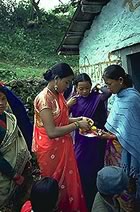 |
|
|
|
|
|
 |
|
|
| Nepal's Religious Festivals |
| Dashain losing hold among ethnic groups |
 |
Ethnic
communities in several parts of country, including Sunsari district, have
been discarding 'Dashain' as part of their tradition. The concept thatDashain does not form part of their culture started about a decade ago.
Most Mongoloid ethnic communities including the Rais, Gurungs, Magars,
Tamangs became conscious that they have their own main festival apart from
Dashain. Scholars have maintained that Dashain finds no mention in 'Mundhum',
the religious book of the Kirants.
This was brought to light after historians, scholars of sociology, anthropologists and cultural experts, recognised over four dozen ethnic communities in the country after the restoration of democracy. Within the ethnic communities, this has bred a negative attitude towards celebrating Dashain. |
People
of various ethnic communities have been celebrating different festivals
as their main festivals, with the government declaring a day holiday on
the main festivals of ethnic communities. Though there has been consensus
from different quarters that Dashain should be developed as a single common
festival in the Himalayan kingdom, the ethnic communities have been stating
that Dashain is a Hindu festival while they are non-Hindu.
The Limbus have Chosakngnam as their main festival while others have their
own main festivals like Loshar and Sakewa. Tamang, Gurung and Sherpa have
been celebrating Loshar as their main festival and they have stopped observing
Dashain festival in many parts of the country.
However,
the elite among the ethnic communities still celebrate Dashain with fanfare
as usual.
| 'Kalai Lagaune', unique festival of western Nepal |
During Ghatasthapana, the first day of the Dashain festival, the populace in far-western
Nepal celebrate another festival called "Kalai Lagaune," regarded as an
opportunity to pay homage to mother earth, that is unique to the region.
As part of an age-old practice, the locals on this day, collect ripe paddy
stalks in the morning, offer prayers on the earth from where the stalk
is removed, offer some of the paddy stalks to their family deity and with
the remaining they observe the Kalai Festival.
During
the Kalai festival, locals decorate the upper portion of the main door
with paddy stalks. The stalks are kept hanging with the aid of dung, into
which copper coins are also imbedded. Offering prayers to the granary also
forms one of the more important functions of the ceremony.
Unlike
during the harvesting, paddy stalks for the festival have to be snapped
off with fingernails, and only the women are allowed to do this, usually
the mother of the house. To prepare for the stalk plucking the women take
a bath early in the morning and wear clean clothes.
In
the afternoon, delicious food is prepared and items of food are exchanged
among households, a tradition meant to consolidate ties among the neighbours.
"The festival is an opportunity to express gratitude to mother earth which
provides life-giving food,"a local siad.
People believe that the festival delivers a good harvest, economic prosperity and higher productivity. However, with the passage of time Kalai festival is on the wane, as the new generations seem less interested in continuing traditions.